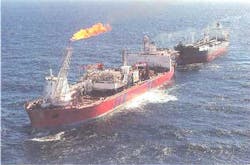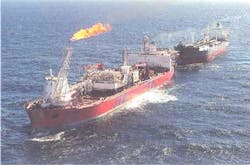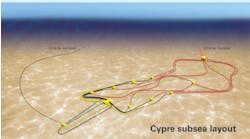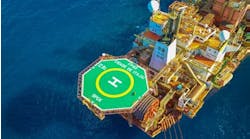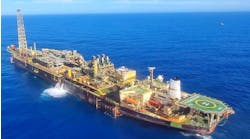FLOATING TECHNOLOGY: Challenges in obtaining long life from floating producer coatings
Long life coating systems are required to keep FPSOs clean from marine life for years.
During recent years, the use of floating production systems (FPS) has increased considerably. This development was driven by the development of deepwater oil and gas fields, where seabed-fixed structures were not possible, and the need for lower initial investment to make smaller oil fields more economic.
One type of FPS is the FPSO (floating production, storage, and offloading) unit. These units are the most versatile of the FPS and now dominate the deepwater offshore. With the emergence of these units, the marine paint industry faces a significant challenge.
Once on station, these units cannot be moved for regular drydocking. The production loss and disruption and other costs such as suspending the well dictate the need for long life systems - up to 20+ years. Also, the possibility of doing maintenance onsite, especially in inaccessible areas such as tanks that are in continuous use, is very limited. Thus, hull and facility coatings must be done right the first time.
Requirements
We can identify a few key areas of an FPSO that have typical requirements:
- Underwater area on outside hull: The key for coatings in this area is abrasion resistance to ensure long life protection. Anti-corrosive systems for this area are normally pure epoxy coatings (sometimes with glass-flake added for additional abrasion resistance). New developments for this area are solvent-free epoxy coatings that also provide excellent protection against wear and tear. The need for an antifouling system is dependent on the location where the unit will be stationed. If this is in cold water areas, such as the North Atlantic, there is no real need as fouling activity is very low. However, if it is to operate in tropical or sub-tropical waters, there is a need for antifoulings to ensure a clean hull, which facilitates easier underwater hull surveys later. This need can be met with TBT-free, high active self-polishing antifoulings. Also, a small but important part is the sea water inlets. These can best be coated with latest generation silicone-based antifoulings, which work by offering too slippery a surface for attachment by fouling organisms.
- Outside hull above water area: Here, the anti-abrasion properties of the coating are most important. Therefore, pure epoxy-based coatings are normally specified in this area.
- Ballast tanks: The long life time requirements for this area can only be met with either pure epoxy coatings or solvent free epoxy coatings. Whereas, the pure epoxies are normally used in newbuildings, the solvent-free coatings are mainly used in conversions. The reason for this is that, in case of conversions, the steel always will show a level of deterioration. If this deterioration (loss in steel plate thickness due to corrosion) is too much, the steel would have to be replaced. However, if steel plate thickness is still acceptable, there can still be a high level of pitting in the steel. This normally cannot be covered by conventional (modified) epoxy paints, as the film thickness achieved is not high enough to sufficiently fill all of the pits. Also, modified epoxies will age and break down quicker than pure epoxies. This phenomenon will then lead to pitting corrosion and may ultimately lead to structural failure if not repaired in time. Therefore, solvent-free coatings should be used in this particular case, similar to those produced by Sigma Coatings.
- Cargo tanks: These are typically coated only on the tank bottom, about one meter up on the sides, at the deck-head, and about two meters down the sides. In general, the principal considerations in coating these areas are the same as in ballast tanks, so the same coating systems should be applied here. Since the cargo tanks on an FPSO can have diverse cargoes ( for example, hot crude oil in receiving tanks, processed oil or separated water from oil in storage tanks, and oil/well treatment chemicals in other tanks) and temperatures can vary enormously, it may be necessary to adjust systems to cater for these extraordinary cargoes and circumstances, on a case by case (or tank by tank) basis.
- Decks: This area is subject to many factors influencing the coatings system - traffic of people and machines, heat exposure from the sun, spillage of chemicals and oil, and other influences. Therefore, a highly abrasion-resistant system with a certain level of chemical resistance is needed here. These consist of epoxies with polyurethane finish coats.
In general, it can be said that due to the long coating system performance needs for these FPSO units, only the top-of-the-line systems will fulfill this requirement. In terms of coatings, this means that on critical areas as mentioned above only pure epoxies or solvent-free coatings will perform adequately. The use of modified epoxy coatings should therefore be avoided, as they do not have the long life characteristics.
